Valuation of Nike's Intrinsic Value
VerifiedAdded on 2019/09/19
|22
|3201
|503
Case Study
AI Summary
The assignment discusses the valuation of Nike's intrinsic value using Gordon's Dividend Growth model and compares it with the value obtained using Discounted Cash Flow (DCF) model. The intrinsic value per share is $23.96 using Gordon's model, which is significantly lower than the value of $124.84 obtained using DCF model. This difference is attributed to the inclusion of retained earnings in the DCF model. The assignment also analyzes Nike's capital structure policy and derives an unlevered beta of 0.36. Finally, it calculates the levered firm value and unlevered cost of equity for Nike.
Contribute Materials
Your contribution can guide someone’s learning journey. Share your
documents today.

Valuation Report: Nike
Secure Best Marks with AI Grader
Need help grading? Try our AI Grader for instant feedback on your assignments.

Valuation Report: Nike
Table of Contents
Question 1.............................................................................................................................................2
Question 2.............................................................................................................................................5
Question 3.............................................................................................................................................6
Question 4.............................................................................................................................................7
Question 5...........................................................................................................................................10
Question 6...........................................................................................................................................11
Question 7...........................................................................................................................................13
Question 8...........................................................................................................................................14
Question 9...........................................................................................................................................16
Question 10.........................................................................................................................................17
Question 11.........................................................................................................................................18
Question 12.........................................................................................................................................19
Question 13.........................................................................................................................................20
Question 14.........................................................................................................................................21
Question 15.........................................................................................................................................23
References...........................................................................................................................................24
1
Table of Contents
Question 1.............................................................................................................................................2
Question 2.............................................................................................................................................5
Question 3.............................................................................................................................................6
Question 4.............................................................................................................................................7
Question 5...........................................................................................................................................10
Question 6...........................................................................................................................................11
Question 7...........................................................................................................................................13
Question 8...........................................................................................................................................14
Question 9...........................................................................................................................................16
Question 10.........................................................................................................................................17
Question 11.........................................................................................................................................18
Question 12.........................................................................................................................................19
Question 13.........................................................................................................................................20
Question 14.........................................................................................................................................21
Question 15.........................................................................................................................................23
References...........................................................................................................................................24
1
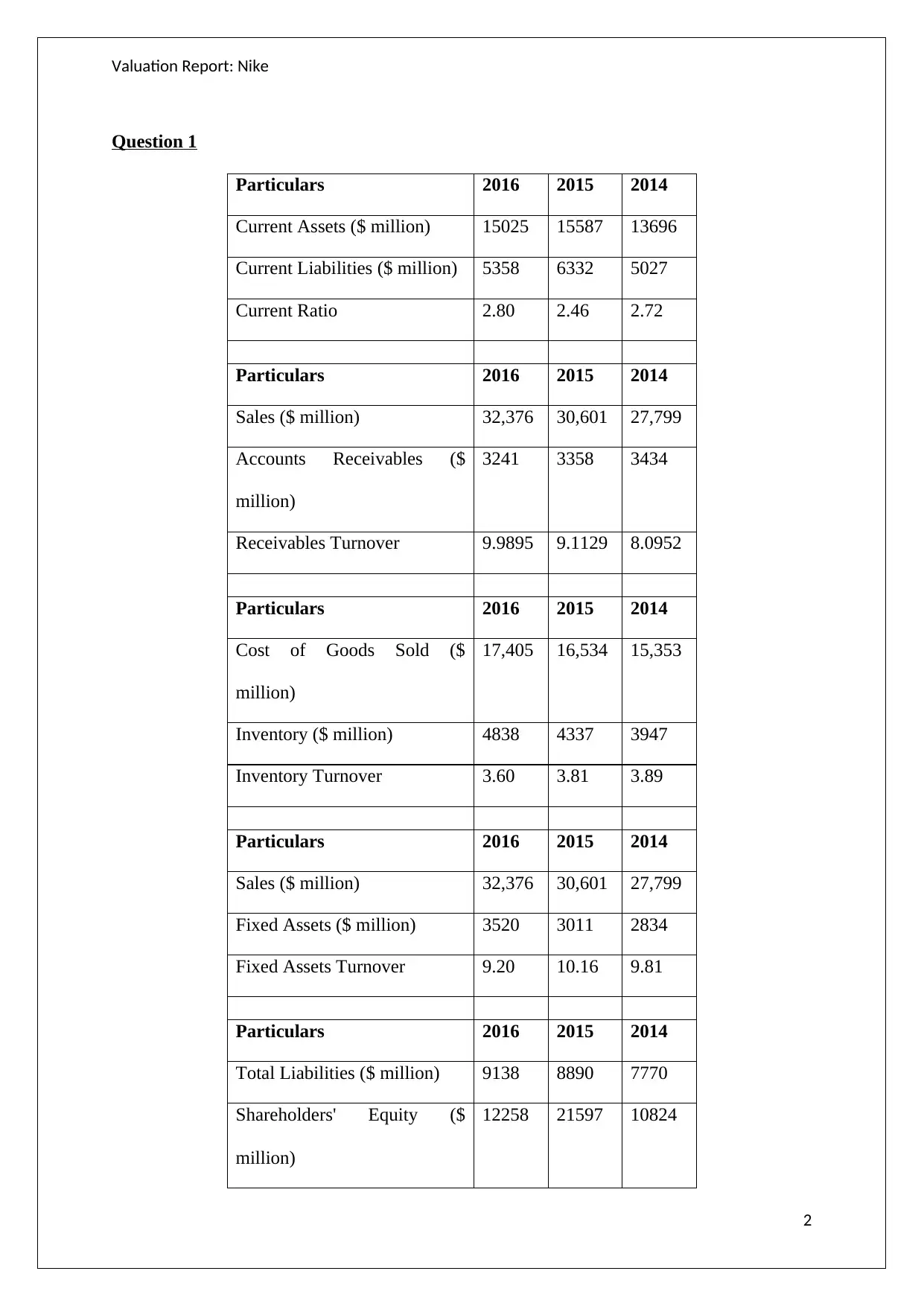
Valuation Report: Nike
Question 1
Particulars 2016 2015 2014
Current Assets ($ million) 15025 15587 13696
Current Liabilities ($ million) 5358 6332 5027
Current Ratio 2.80 2.46 2.72
Particulars 2016 2015 2014
Sales ($ million) 32,376 30,601 27,799
Accounts Receivables ($
million)
3241 3358 3434
Receivables Turnover 9.9895 9.1129 8.0952
Particulars 2016 2015 2014
Cost of Goods Sold ($
million)
17,405 16,534 15,353
Inventory ($ million) 4838 4337 3947
Inventory Turnover 3.60 3.81 3.89
Particulars 2016 2015 2014
Sales ($ million) 32,376 30,601 27,799
Fixed Assets ($ million) 3520 3011 2834
Fixed Assets Turnover 9.20 10.16 9.81
Particulars 2016 2015 2014
Total Liabilities ($ million) 9138 8890 7770
Shareholders' Equity ($
million)
12258 21597 10824
2
Question 1
Particulars 2016 2015 2014
Current Assets ($ million) 15025 15587 13696
Current Liabilities ($ million) 5358 6332 5027
Current Ratio 2.80 2.46 2.72
Particulars 2016 2015 2014
Sales ($ million) 32,376 30,601 27,799
Accounts Receivables ($
million)
3241 3358 3434
Receivables Turnover 9.9895 9.1129 8.0952
Particulars 2016 2015 2014
Cost of Goods Sold ($
million)
17,405 16,534 15,353
Inventory ($ million) 4838 4337 3947
Inventory Turnover 3.60 3.81 3.89
Particulars 2016 2015 2014
Sales ($ million) 32,376 30,601 27,799
Fixed Assets ($ million) 3520 3011 2834
Fixed Assets Turnover 9.20 10.16 9.81
Particulars 2016 2015 2014
Total Liabilities ($ million) 9138 8890 7770
Shareholders' Equity ($
million)
12258 21597 10824
2

Valuation Report: Nike
Debt-Equity Ratio 0.75 0.41 0.72
Particulars 2016 2015 2014
Sales ($ million) 32,376 30,601 27,799
Operating Profit ($ million) 4642 4233 3577
Operating Margin 14.34% 13.83
%
12.87%
Particulars 2016 2015 2014
Sales ($ million) 32,376 30,601 27,799
Net Profit ($ million) 3760 3273 2693
Net Profit Margin 11.61% 10.70
%
9.69%
Particulars 2016 2015 2014
Net Profit ($ million) 3760 3273 2693
Total Assets ($ million) 21396 21597 18594
Return on Assets 17.57% 15.15
%
14.48%
Particulars 2016 2015 2014
Operating Profit ($ million) 4642 4233 3577
Total Assets ($ million) 21396 21597 18594
Current Liabilities ($ million) 5358 6332 5027
Capital Employed ($ million) 16038 15265 13567
Return on Capital Employed 28.94% 27.73
%
26.37%
3
Debt-Equity Ratio 0.75 0.41 0.72
Particulars 2016 2015 2014
Sales ($ million) 32,376 30,601 27,799
Operating Profit ($ million) 4642 4233 3577
Operating Margin 14.34% 13.83
%
12.87%
Particulars 2016 2015 2014
Sales ($ million) 32,376 30,601 27,799
Net Profit ($ million) 3760 3273 2693
Net Profit Margin 11.61% 10.70
%
9.69%
Particulars 2016 2015 2014
Net Profit ($ million) 3760 3273 2693
Total Assets ($ million) 21396 21597 18594
Return on Assets 17.57% 15.15
%
14.48%
Particulars 2016 2015 2014
Operating Profit ($ million) 4642 4233 3577
Total Assets ($ million) 21396 21597 18594
Current Liabilities ($ million) 5358 6332 5027
Capital Employed ($ million) 16038 15265 13567
Return on Capital Employed 28.94% 27.73
%
26.37%
3
Paraphrase This Document
Need a fresh take? Get an instant paraphrase of this document with our AI Paraphraser
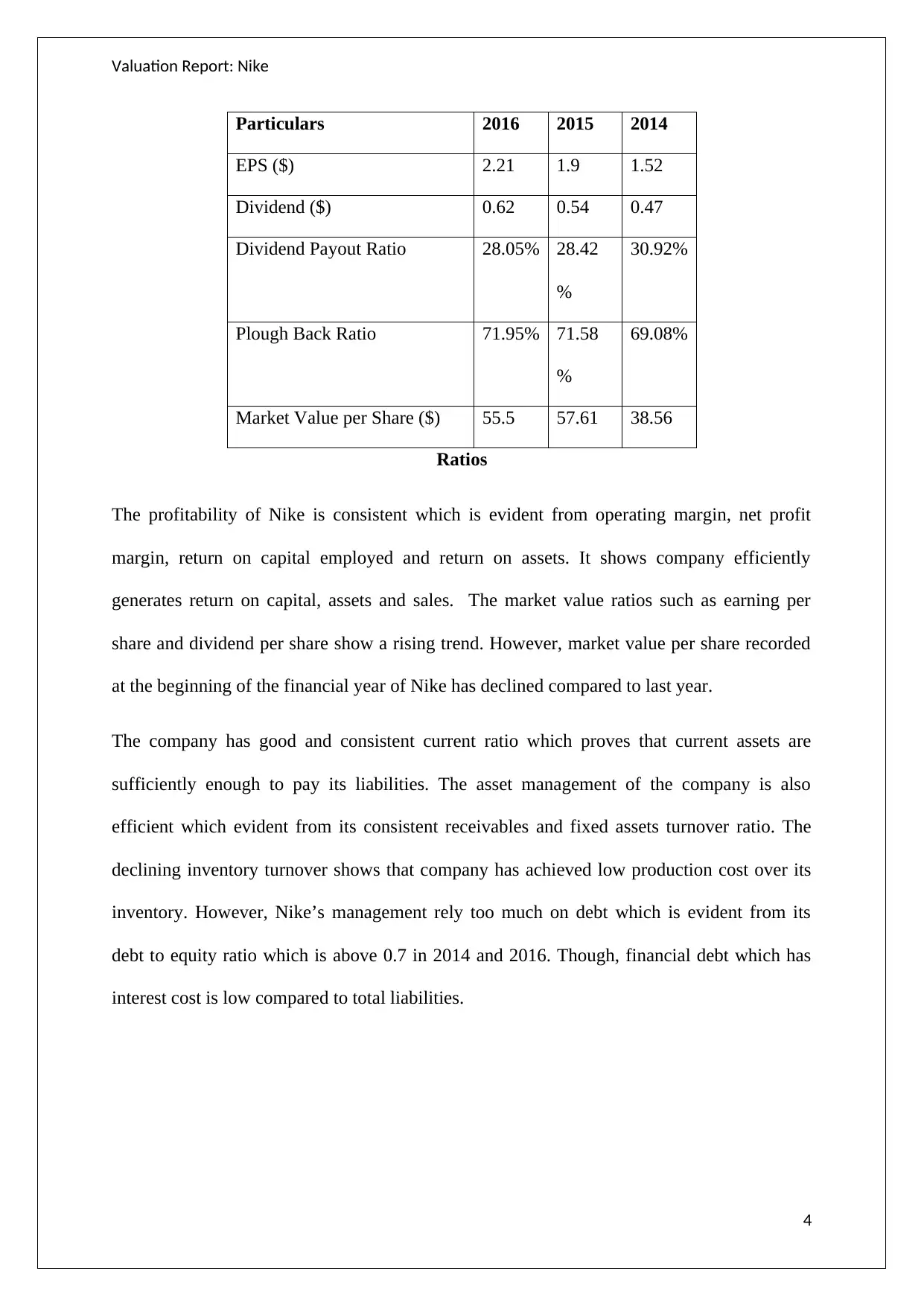
Valuation Report: Nike
Particulars 2016 2015 2014
EPS ($) 2.21 1.9 1.52
Dividend ($) 0.62 0.54 0.47
Dividend Payout Ratio 28.05% 28.42
%
30.92%
Plough Back Ratio 71.95% 71.58
%
69.08%
Market Value per Share ($) 55.5 57.61 38.56
Ratios
The profitability of Nike is consistent which is evident from operating margin, net profit
margin, return on capital employed and return on assets. It shows company efficiently
generates return on capital, assets and sales. The market value ratios such as earning per
share and dividend per share show a rising trend. However, market value per share recorded
at the beginning of the financial year of Nike has declined compared to last year.
The company has good and consistent current ratio which proves that current assets are
sufficiently enough to pay its liabilities. The asset management of the company is also
efficient which evident from its consistent receivables and fixed assets turnover ratio. The
declining inventory turnover shows that company has achieved low production cost over its
inventory. However, Nike’s management rely too much on debt which is evident from its
debt to equity ratio which is above 0.7 in 2014 and 2016. Though, financial debt which has
interest cost is low compared to total liabilities.
4
Particulars 2016 2015 2014
EPS ($) 2.21 1.9 1.52
Dividend ($) 0.62 0.54 0.47
Dividend Payout Ratio 28.05% 28.42
%
30.92%
Plough Back Ratio 71.95% 71.58
%
69.08%
Market Value per Share ($) 55.5 57.61 38.56
Ratios
The profitability of Nike is consistent which is evident from operating margin, net profit
margin, return on capital employed and return on assets. It shows company efficiently
generates return on capital, assets and sales. The market value ratios such as earning per
share and dividend per share show a rising trend. However, market value per share recorded
at the beginning of the financial year of Nike has declined compared to last year.
The company has good and consistent current ratio which proves that current assets are
sufficiently enough to pay its liabilities. The asset management of the company is also
efficient which evident from its consistent receivables and fixed assets turnover ratio. The
declining inventory turnover shows that company has achieved low production cost over its
inventory. However, Nike’s management rely too much on debt which is evident from its
debt to equity ratio which is above 0.7 in 2014 and 2016. Though, financial debt which has
interest cost is low compared to total liabilities.
4
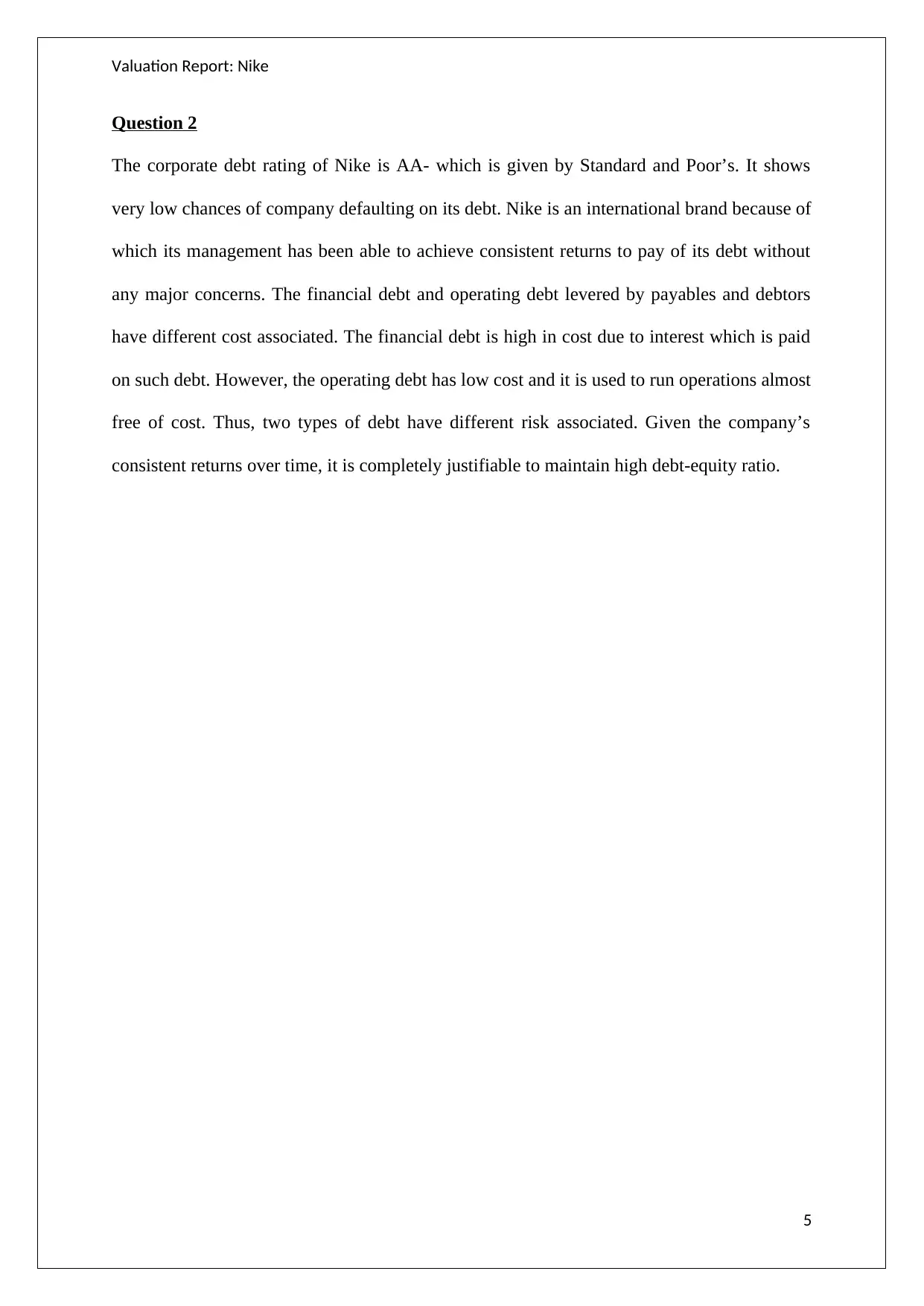
Valuation Report: Nike
Question 2
The corporate debt rating of Nike is AA- which is given by Standard and Poor’s. It shows
very low chances of company defaulting on its debt. Nike is an international brand because of
which its management has been able to achieve consistent returns to pay of its debt without
any major concerns. The financial debt and operating debt levered by payables and debtors
have different cost associated. The financial debt is high in cost due to interest which is paid
on such debt. However, the operating debt has low cost and it is used to run operations almost
free of cost. Thus, two types of debt have different risk associated. Given the company’s
consistent returns over time, it is completely justifiable to maintain high debt-equity ratio.
5
Question 2
The corporate debt rating of Nike is AA- which is given by Standard and Poor’s. It shows
very low chances of company defaulting on its debt. Nike is an international brand because of
which its management has been able to achieve consistent returns to pay of its debt without
any major concerns. The financial debt and operating debt levered by payables and debtors
have different cost associated. The financial debt is high in cost due to interest which is paid
on such debt. However, the operating debt has low cost and it is used to run operations almost
free of cost. Thus, two types of debt have different risk associated. Given the company’s
consistent returns over time, it is completely justifiable to maintain high debt-equity ratio.
5
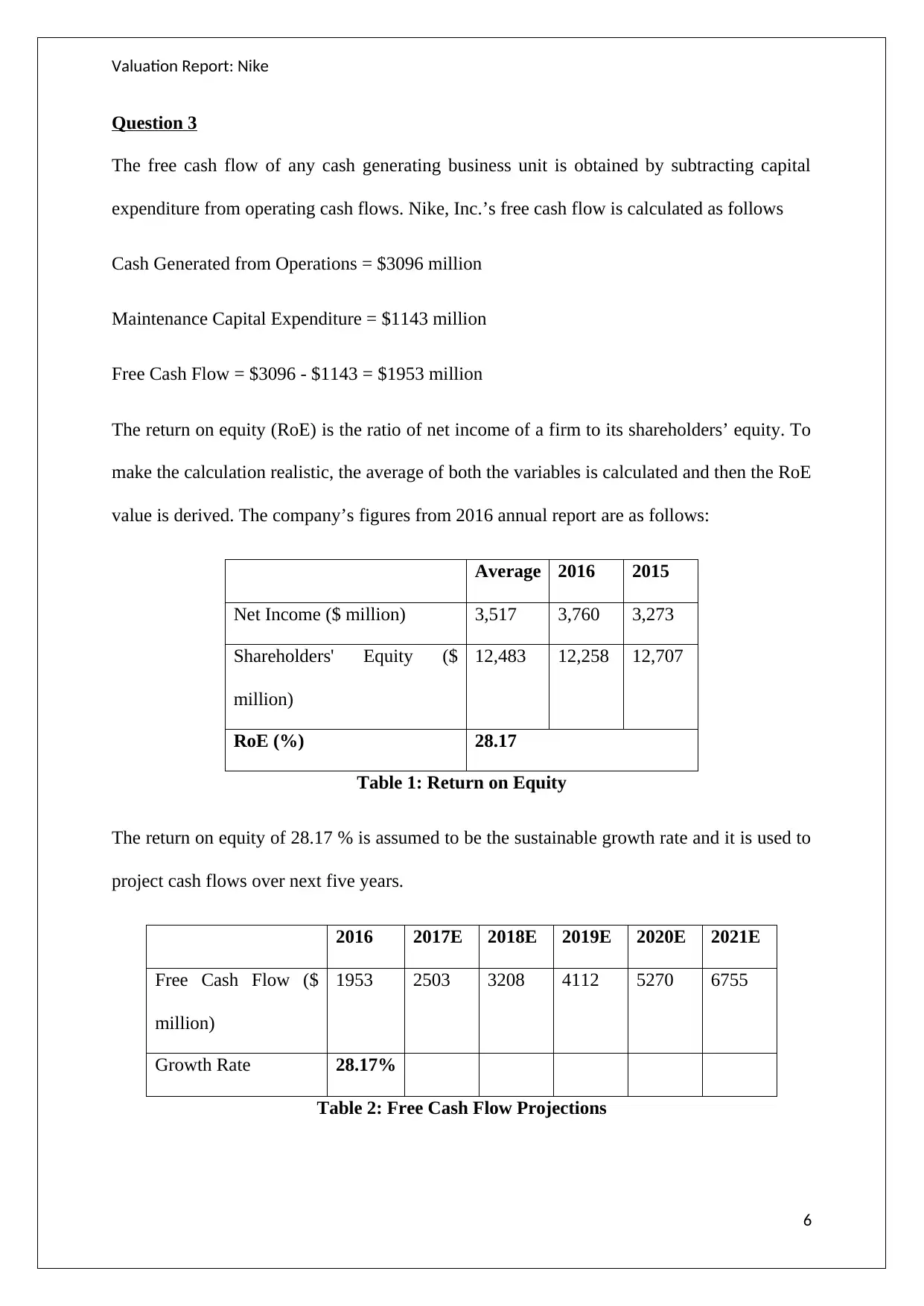
Valuation Report: Nike
Question 3
The free cash flow of any cash generating business unit is obtained by subtracting capital
expenditure from operating cash flows. Nike, Inc.’s free cash flow is calculated as follows
Cash Generated from Operations = $3096 million
Maintenance Capital Expenditure = $1143 million
Free Cash Flow = $3096 - $1143 = $1953 million
The return on equity (RoE) is the ratio of net income of a firm to its shareholders’ equity. To
make the calculation realistic, the average of both the variables is calculated and then the RoE
value is derived. The company’s figures from 2016 annual report are as follows:
Average 2016 2015
Net Income ($ million) 3,517 3,760 3,273
Shareholders' Equity ($
million)
12,483 12,258 12,707
RoE (%) 28.17
Table 1: Return on Equity
The return on equity of 28.17 % is assumed to be the sustainable growth rate and it is used to
project cash flows over next five years.
2016 2017E 2018E 2019E 2020E 2021E
Free Cash Flow ($
million)
1953 2503 3208 4112 5270 6755
Growth Rate 28.17%
Table 2: Free Cash Flow Projections
6
Question 3
The free cash flow of any cash generating business unit is obtained by subtracting capital
expenditure from operating cash flows. Nike, Inc.’s free cash flow is calculated as follows
Cash Generated from Operations = $3096 million
Maintenance Capital Expenditure = $1143 million
Free Cash Flow = $3096 - $1143 = $1953 million
The return on equity (RoE) is the ratio of net income of a firm to its shareholders’ equity. To
make the calculation realistic, the average of both the variables is calculated and then the RoE
value is derived. The company’s figures from 2016 annual report are as follows:
Average 2016 2015
Net Income ($ million) 3,517 3,760 3,273
Shareholders' Equity ($
million)
12,483 12,258 12,707
RoE (%) 28.17
Table 1: Return on Equity
The return on equity of 28.17 % is assumed to be the sustainable growth rate and it is used to
project cash flows over next five years.
2016 2017E 2018E 2019E 2020E 2021E
Free Cash Flow ($
million)
1953 2503 3208 4112 5270 6755
Growth Rate 28.17%
Table 2: Free Cash Flow Projections
6
Secure Best Marks with AI Grader
Need help grading? Try our AI Grader for instant feedback on your assignments.
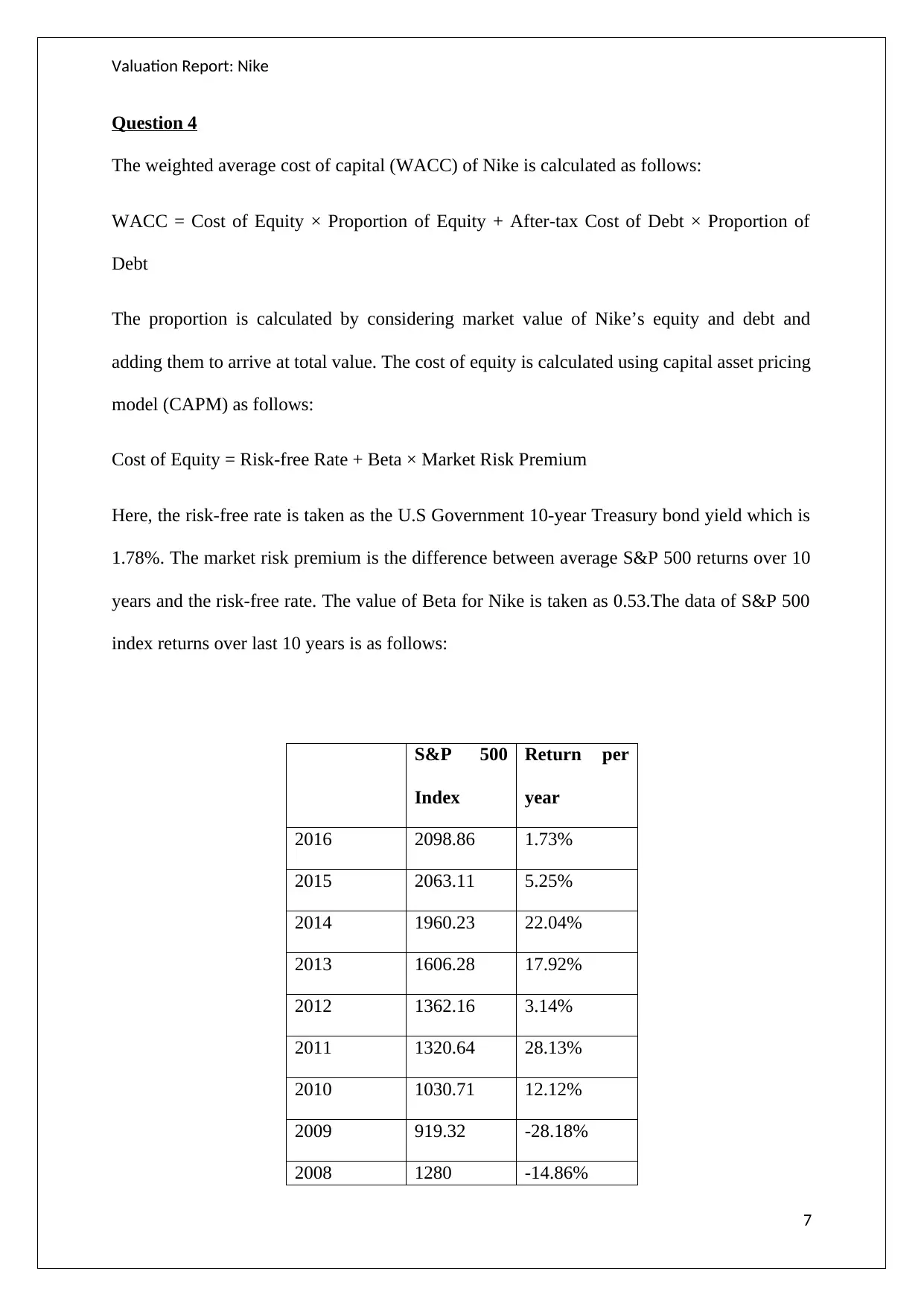
Valuation Report: Nike
Question 4
The weighted average cost of capital (WACC) of Nike is calculated as follows:
WACC = Cost of Equity × Proportion of Equity + After-tax Cost of Debt × Proportion of
Debt
The proportion is calculated by considering market value of Nike’s equity and debt and
adding them to arrive at total value. The cost of equity is calculated using capital asset pricing
model (CAPM) as follows:
Cost of Equity = Risk-free Rate + Beta × Market Risk Premium
Here, the risk-free rate is taken as the U.S Government 10-year Treasury bond yield which is
1.78%. The market risk premium is the difference between average S&P 500 returns over 10
years and the risk-free rate. The value of Beta for Nike is taken as 0.53.The data of S&P 500
index returns over last 10 years is as follows:
S&P 500
Index
Return per
year
2016 2098.86 1.73%
2015 2063.11 5.25%
2014 1960.23 22.04%
2013 1606.28 17.92%
2012 1362.16 3.14%
2011 1320.64 28.13%
2010 1030.71 12.12%
2009 919.32 -28.18%
2008 1280 -14.86%
7
Question 4
The weighted average cost of capital (WACC) of Nike is calculated as follows:
WACC = Cost of Equity × Proportion of Equity + After-tax Cost of Debt × Proportion of
Debt
The proportion is calculated by considering market value of Nike’s equity and debt and
adding them to arrive at total value. The cost of equity is calculated using capital asset pricing
model (CAPM) as follows:
Cost of Equity = Risk-free Rate + Beta × Market Risk Premium
Here, the risk-free rate is taken as the U.S Government 10-year Treasury bond yield which is
1.78%. The market risk premium is the difference between average S&P 500 returns over 10
years and the risk-free rate. The value of Beta for Nike is taken as 0.53.The data of S&P 500
index returns over last 10 years is as follows:
S&P 500
Index
Return per
year
2016 2098.86 1.73%
2015 2063.11 5.25%
2014 1960.23 22.04%
2013 1606.28 17.92%
2012 1362.16 3.14%
2011 1320.64 28.13%
2010 1030.71 12.12%
2009 919.32 -28.18%
2008 1280 -14.86%
7
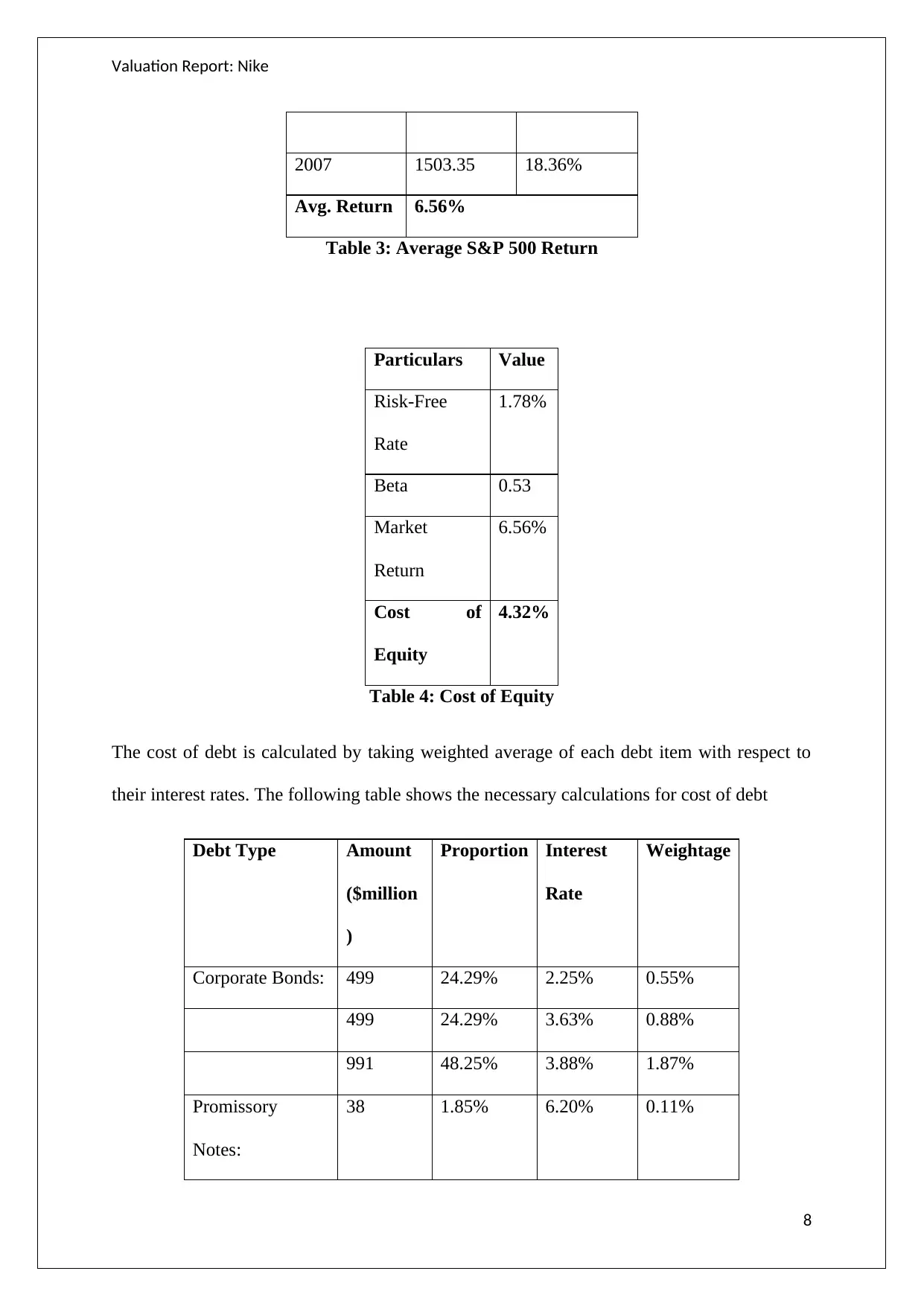
Valuation Report: Nike
2007 1503.35 18.36%
Avg. Return 6.56%
Table 3: Average S&P 500 Return
Particulars Value
Risk-Free
Rate
1.78%
Beta 0.53
Market
Return
6.56%
Cost of
Equity
4.32%
Table 4: Cost of Equity
The cost of debt is calculated by taking weighted average of each debt item with respect to
their interest rates. The following table shows the necessary calculations for cost of debt
Debt Type Amount
($million
)
Proportion Interest
Rate
Weightage
Corporate Bonds: 499 24.29% 2.25% 0.55%
499 24.29% 3.63% 0.88%
991 48.25% 3.88% 1.87%
Promissory
Notes:
38 1.85% 6.20% 0.11%
8
2007 1503.35 18.36%
Avg. Return 6.56%
Table 3: Average S&P 500 Return
Particulars Value
Risk-Free
Rate
1.78%
Beta 0.53
Market
Return
6.56%
Cost of
Equity
4.32%
Table 4: Cost of Equity
The cost of debt is calculated by taking weighted average of each debt item with respect to
their interest rates. The following table shows the necessary calculations for cost of debt
Debt Type Amount
($million
)
Proportion Interest
Rate
Weightage
Corporate Bonds: 499 24.29% 2.25% 0.55%
499 24.29% 3.63% 0.88%
991 48.25% 3.88% 1.87%
Promissory
Notes:
38 1.85% 6.20% 0.11%
8
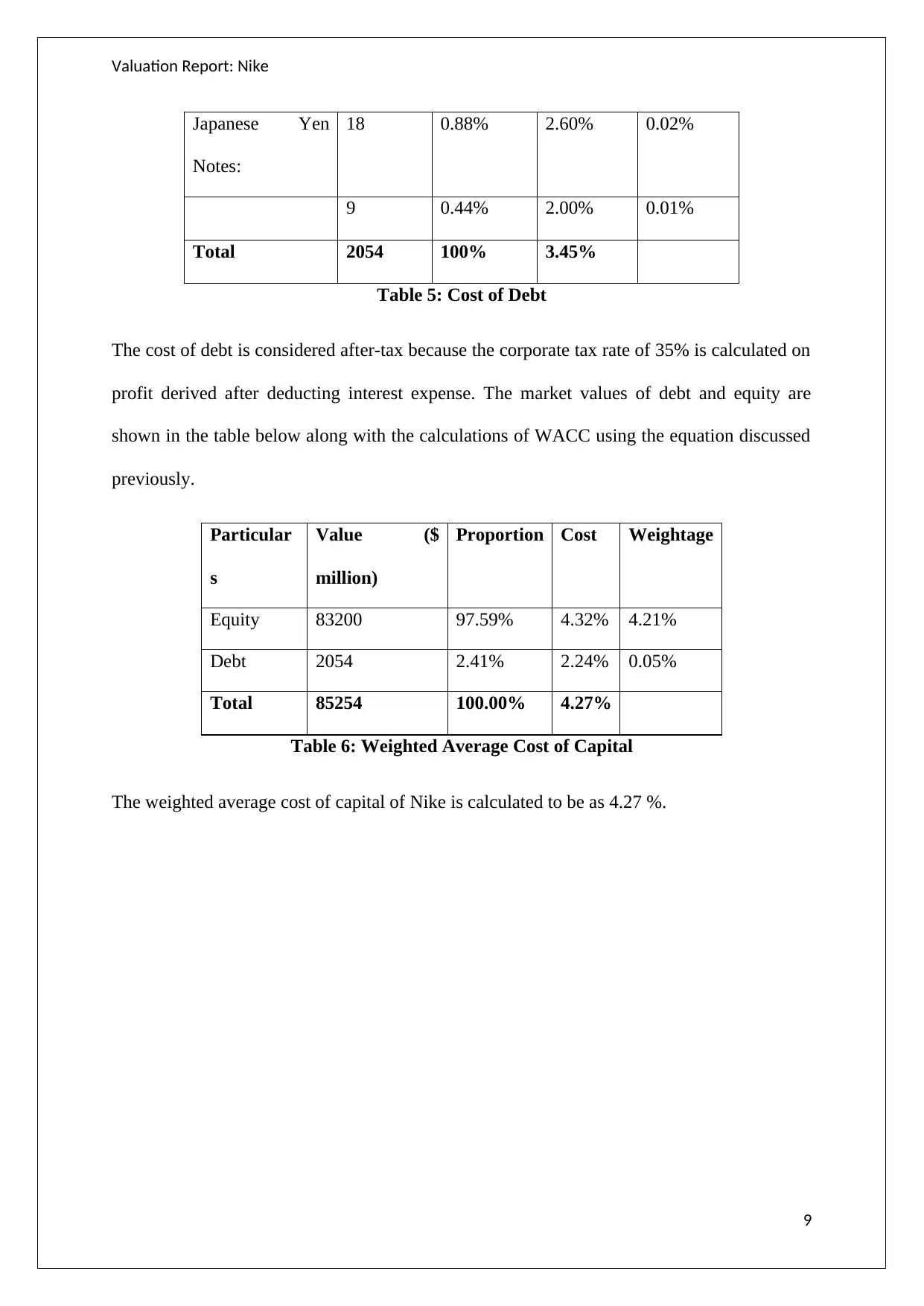
Valuation Report: Nike
Japanese Yen
Notes:
18 0.88% 2.60% 0.02%
9 0.44% 2.00% 0.01%
Total 2054 100% 3.45%
Table 5: Cost of Debt
The cost of debt is considered after-tax because the corporate tax rate of 35% is calculated on
profit derived after deducting interest expense. The market values of debt and equity are
shown in the table below along with the calculations of WACC using the equation discussed
previously.
Particular
s
Value ($
million)
Proportion Cost Weightage
Equity 83200 97.59% 4.32% 4.21%
Debt 2054 2.41% 2.24% 0.05%
Total 85254 100.00% 4.27%
Table 6: Weighted Average Cost of Capital
The weighted average cost of capital of Nike is calculated to be as 4.27 %.
9
Japanese Yen
Notes:
18 0.88% 2.60% 0.02%
9 0.44% 2.00% 0.01%
Total 2054 100% 3.45%
Table 5: Cost of Debt
The cost of debt is considered after-tax because the corporate tax rate of 35% is calculated on
profit derived after deducting interest expense. The market values of debt and equity are
shown in the table below along with the calculations of WACC using the equation discussed
previously.
Particular
s
Value ($
million)
Proportion Cost Weightage
Equity 83200 97.59% 4.32% 4.21%
Debt 2054 2.41% 2.24% 0.05%
Total 85254 100.00% 4.27%
Table 6: Weighted Average Cost of Capital
The weighted average cost of capital of Nike is calculated to be as 4.27 %.
9
Paraphrase This Document
Need a fresh take? Get an instant paraphrase of this document with our AI Paraphraser
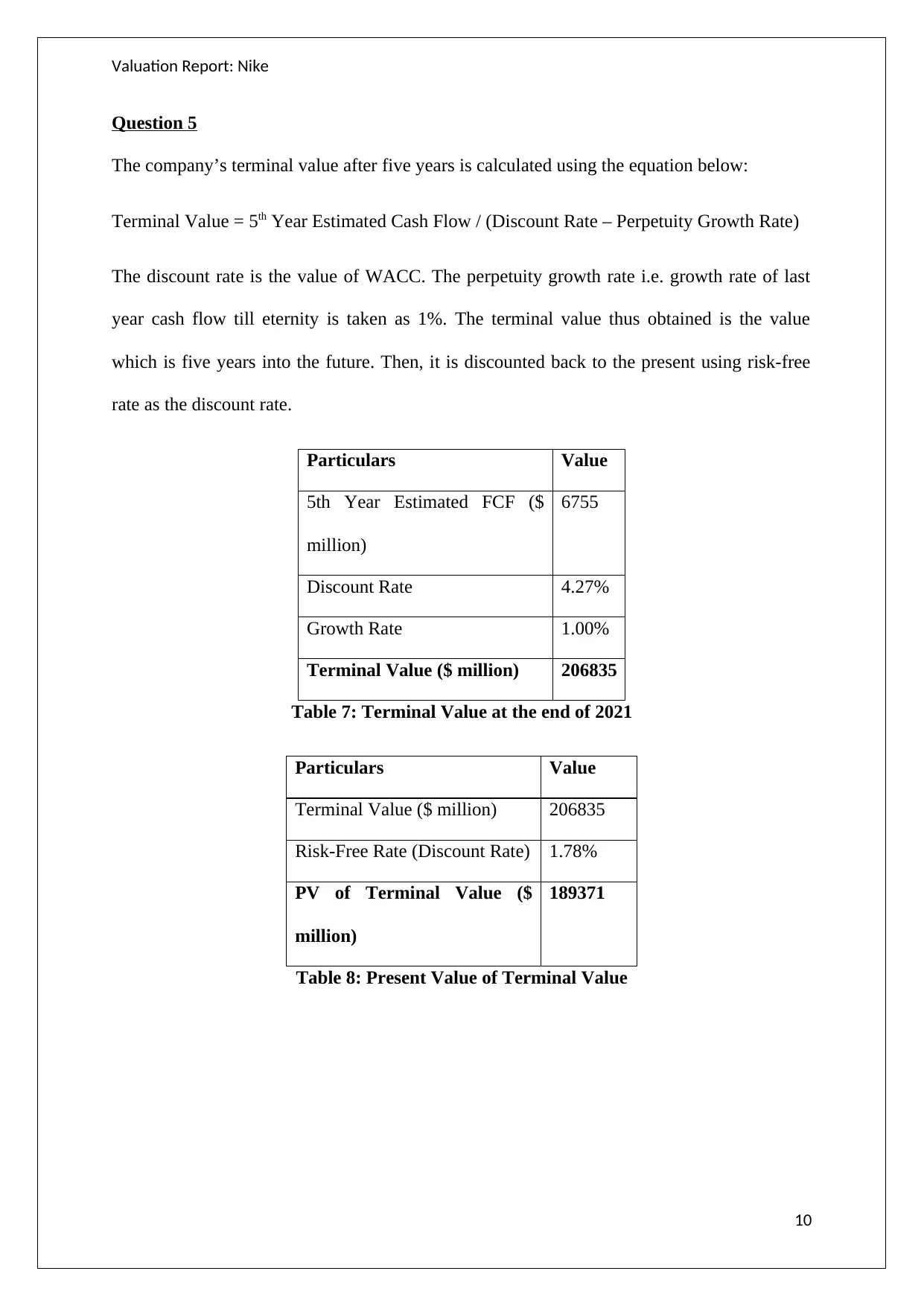
Valuation Report: Nike
Question 5
The company’s terminal value after five years is calculated using the equation below:
Terminal Value = 5th Year Estimated Cash Flow / (Discount Rate – Perpetuity Growth Rate)
The discount rate is the value of WACC. The perpetuity growth rate i.e. growth rate of last
year cash flow till eternity is taken as 1%. The terminal value thus obtained is the value
which is five years into the future. Then, it is discounted back to the present using risk-free
rate as the discount rate.
Particulars Value
5th Year Estimated FCF ($
million)
6755
Discount Rate 4.27%
Growth Rate 1.00%
Terminal Value ($ million) 206835
Table 7: Terminal Value at the end of 2021
Particulars Value
Terminal Value ($ million) 206835
Risk-Free Rate (Discount Rate) 1.78%
PV of Terminal Value ($
million)
189371
Table 8: Present Value of Terminal Value
10
Question 5
The company’s terminal value after five years is calculated using the equation below:
Terminal Value = 5th Year Estimated Cash Flow / (Discount Rate – Perpetuity Growth Rate)
The discount rate is the value of WACC. The perpetuity growth rate i.e. growth rate of last
year cash flow till eternity is taken as 1%. The terminal value thus obtained is the value
which is five years into the future. Then, it is discounted back to the present using risk-free
rate as the discount rate.
Particulars Value
5th Year Estimated FCF ($
million)
6755
Discount Rate 4.27%
Growth Rate 1.00%
Terminal Value ($ million) 206835
Table 7: Terminal Value at the end of 2021
Particulars Value
Terminal Value ($ million) 206835
Risk-Free Rate (Discount Rate) 1.78%
PV of Terminal Value ($
million)
189371
Table 8: Present Value of Terminal Value
10
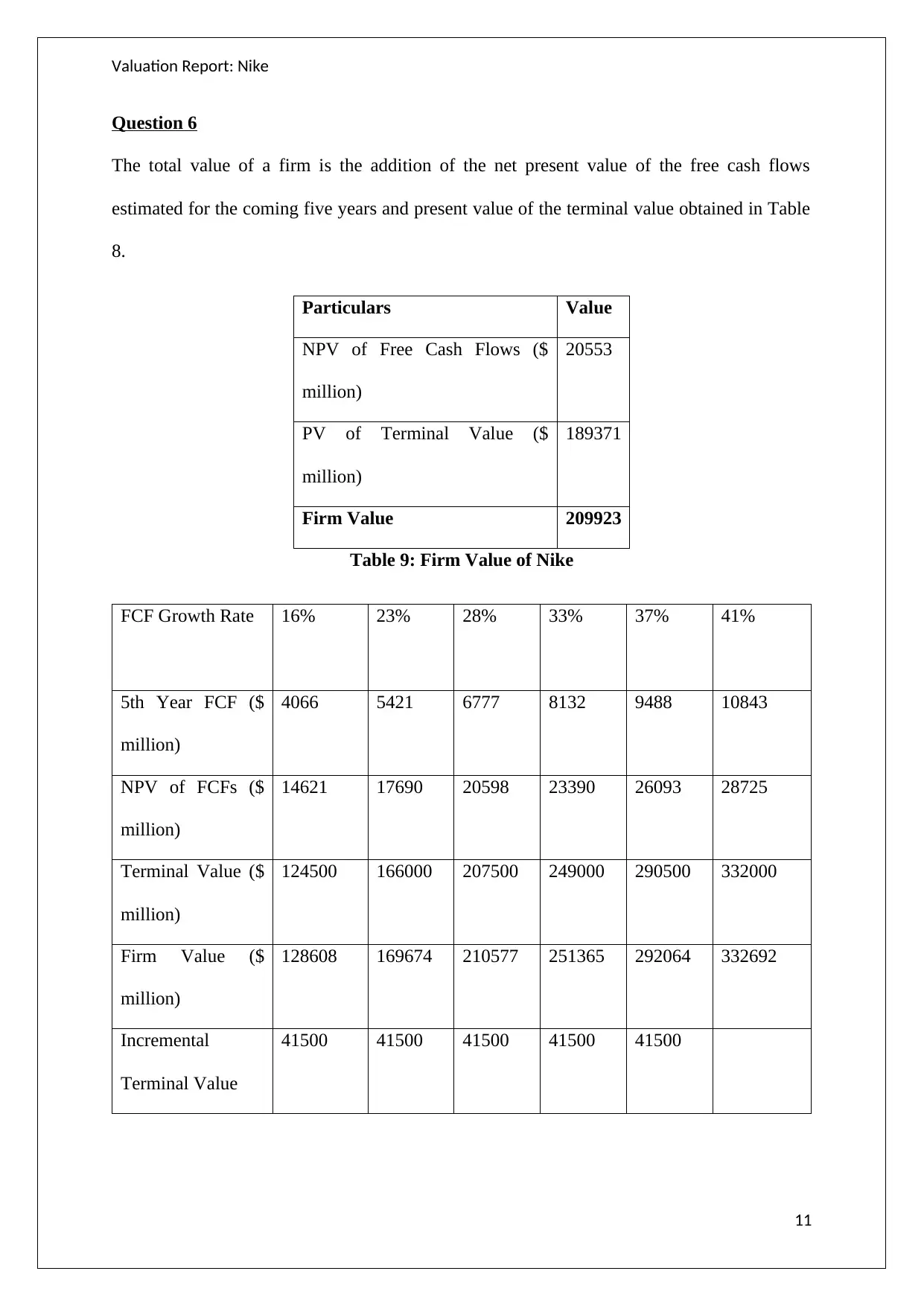
Valuation Report: Nike
Question 6
The total value of a firm is the addition of the net present value of the free cash flows
estimated for the coming five years and present value of the terminal value obtained in Table
8.
Particulars Value
NPV of Free Cash Flows ($
million)
20553
PV of Terminal Value ($
million)
189371
Firm Value 209923
Table 9: Firm Value of Nike
FCF Growth Rate 16% 23% 28% 33% 37% 41%
5th Year FCF ($
million)
4066 5421 6777 8132 9488 10843
NPV of FCFs ($
million)
14621 17690 20598 23390 26093 28725
Terminal Value ($
million)
124500 166000 207500 249000 290500 332000
Firm Value ($
million)
128608 169674 210577 251365 292064 332692
Incremental
Terminal Value
41500 41500 41500 41500 41500
11
Question 6
The total value of a firm is the addition of the net present value of the free cash flows
estimated for the coming five years and present value of the terminal value obtained in Table
8.
Particulars Value
NPV of Free Cash Flows ($
million)
20553
PV of Terminal Value ($
million)
189371
Firm Value 209923
Table 9: Firm Value of Nike
FCF Growth Rate 16% 23% 28% 33% 37% 41%
5th Year FCF ($
million)
4066 5421 6777 8132 9488 10843
NPV of FCFs ($
million)
14621 17690 20598 23390 26093 28725
Terminal Value ($
million)
124500 166000 207500 249000 290500 332000
Firm Value ($
million)
128608 169674 210577 251365 292064 332692
Incremental
Terminal Value
41500 41500 41500 41500 41500
11
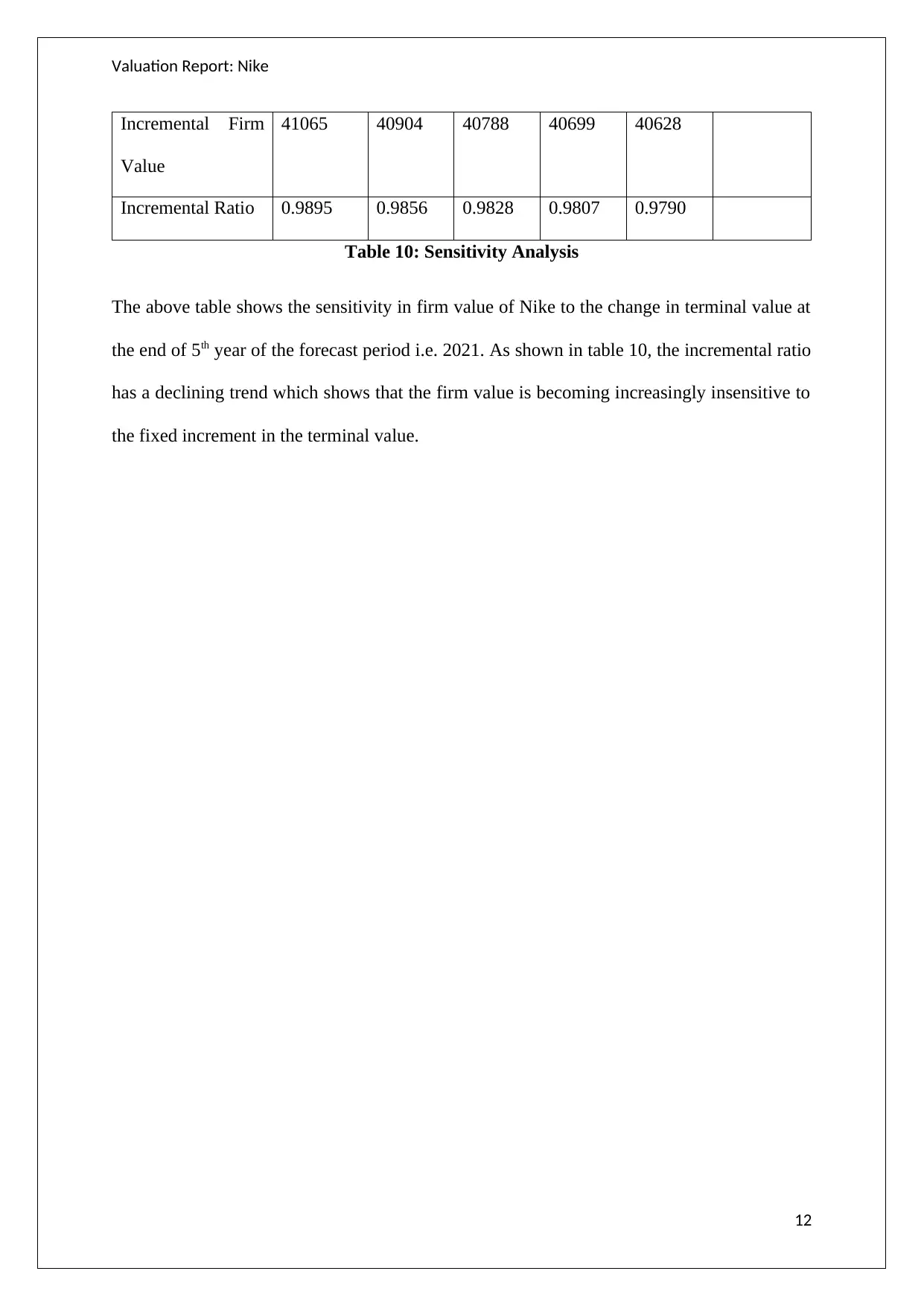
Valuation Report: Nike
Incremental Firm
Value
41065 40904 40788 40699 40628
Incremental Ratio 0.9895 0.9856 0.9828 0.9807 0.9790
Table 10: Sensitivity Analysis
The above table shows the sensitivity in firm value of Nike to the change in terminal value at
the end of 5th year of the forecast period i.e. 2021. As shown in table 10, the incremental ratio
has a declining trend which shows that the firm value is becoming increasingly insensitive to
the fixed increment in the terminal value.
12
Incremental Firm
Value
41065 40904 40788 40699 40628
Incremental Ratio 0.9895 0.9856 0.9828 0.9807 0.9790
Table 10: Sensitivity Analysis
The above table shows the sensitivity in firm value of Nike to the change in terminal value at
the end of 5th year of the forecast period i.e. 2021. As shown in table 10, the incremental ratio
has a declining trend which shows that the firm value is becoming increasingly insensitive to
the fixed increment in the terminal value.
12
Secure Best Marks with AI Grader
Need help grading? Try our AI Grader for instant feedback on your assignments.

Valuation Report: Nike
Question 7
The intrinsic value per share of Nike is obtained by subtracting outstanding debt value from
the firm value obtained in table 9 and then dividing the remainder by outstanding shares of
the company.
Firm Value = $209923 million
Outstanding Debt = $2054 million
After-debt Firm Value = $ 207869 million
Outstanding Shares = 1665 million
Intrinsic Value per Share = $124.84
13
Question 7
The intrinsic value per share of Nike is obtained by subtracting outstanding debt value from
the firm value obtained in table 9 and then dividing the remainder by outstanding shares of
the company.
Firm Value = $209923 million
Outstanding Debt = $2054 million
After-debt Firm Value = $ 207869 million
Outstanding Shares = 1665 million
Intrinsic Value per Share = $124.84
13
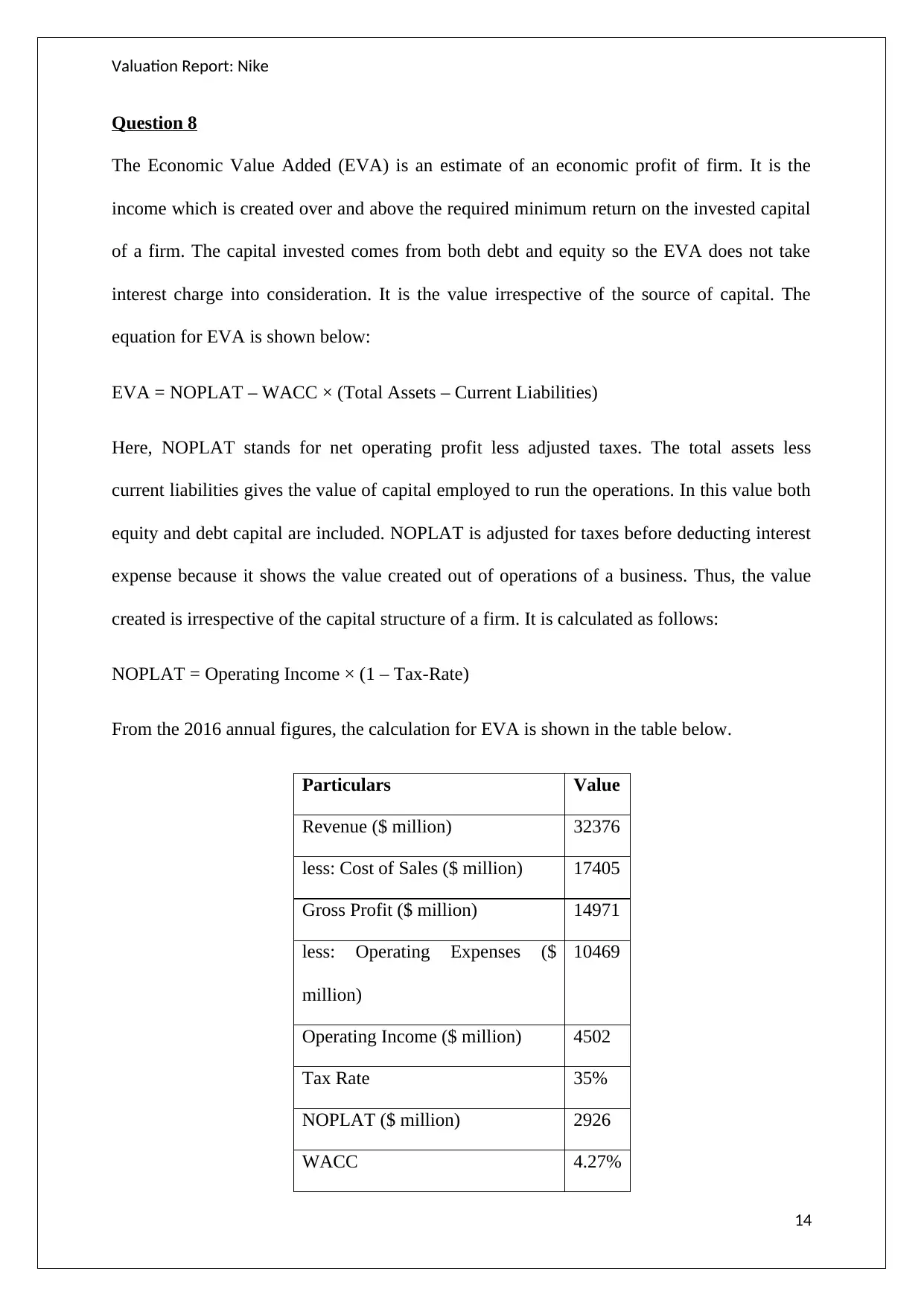
Valuation Report: Nike
Question 8
The Economic Value Added (EVA) is an estimate of an economic profit of firm. It is the
income which is created over and above the required minimum return on the invested capital
of a firm. The capital invested comes from both debt and equity so the EVA does not take
interest charge into consideration. It is the value irrespective of the source of capital. The
equation for EVA is shown below:
EVA = NOPLAT – WACC × (Total Assets – Current Liabilities)
Here, NOPLAT stands for net operating profit less adjusted taxes. The total assets less
current liabilities gives the value of capital employed to run the operations. In this value both
equity and debt capital are included. NOPLAT is adjusted for taxes before deducting interest
expense because it shows the value created out of operations of a business. Thus, the value
created is irrespective of the capital structure of a firm. It is calculated as follows:
NOPLAT = Operating Income × (1 – Tax-Rate)
From the 2016 annual figures, the calculation for EVA is shown in the table below.
Particulars Value
Revenue ($ million) 32376
less: Cost of Sales ($ million) 17405
Gross Profit ($ million) 14971
less: Operating Expenses ($
million)
10469
Operating Income ($ million) 4502
Tax Rate 35%
NOPLAT ($ million) 2926
WACC 4.27%
14
Question 8
The Economic Value Added (EVA) is an estimate of an economic profit of firm. It is the
income which is created over and above the required minimum return on the invested capital
of a firm. The capital invested comes from both debt and equity so the EVA does not take
interest charge into consideration. It is the value irrespective of the source of capital. The
equation for EVA is shown below:
EVA = NOPLAT – WACC × (Total Assets – Current Liabilities)
Here, NOPLAT stands for net operating profit less adjusted taxes. The total assets less
current liabilities gives the value of capital employed to run the operations. In this value both
equity and debt capital are included. NOPLAT is adjusted for taxes before deducting interest
expense because it shows the value created out of operations of a business. Thus, the value
created is irrespective of the capital structure of a firm. It is calculated as follows:
NOPLAT = Operating Income × (1 – Tax-Rate)
From the 2016 annual figures, the calculation for EVA is shown in the table below.
Particulars Value
Revenue ($ million) 32376
less: Cost of Sales ($ million) 17405
Gross Profit ($ million) 14971
less: Operating Expenses ($
million)
10469
Operating Income ($ million) 4502
Tax Rate 35%
NOPLAT ($ million) 2926
WACC 4.27%
14
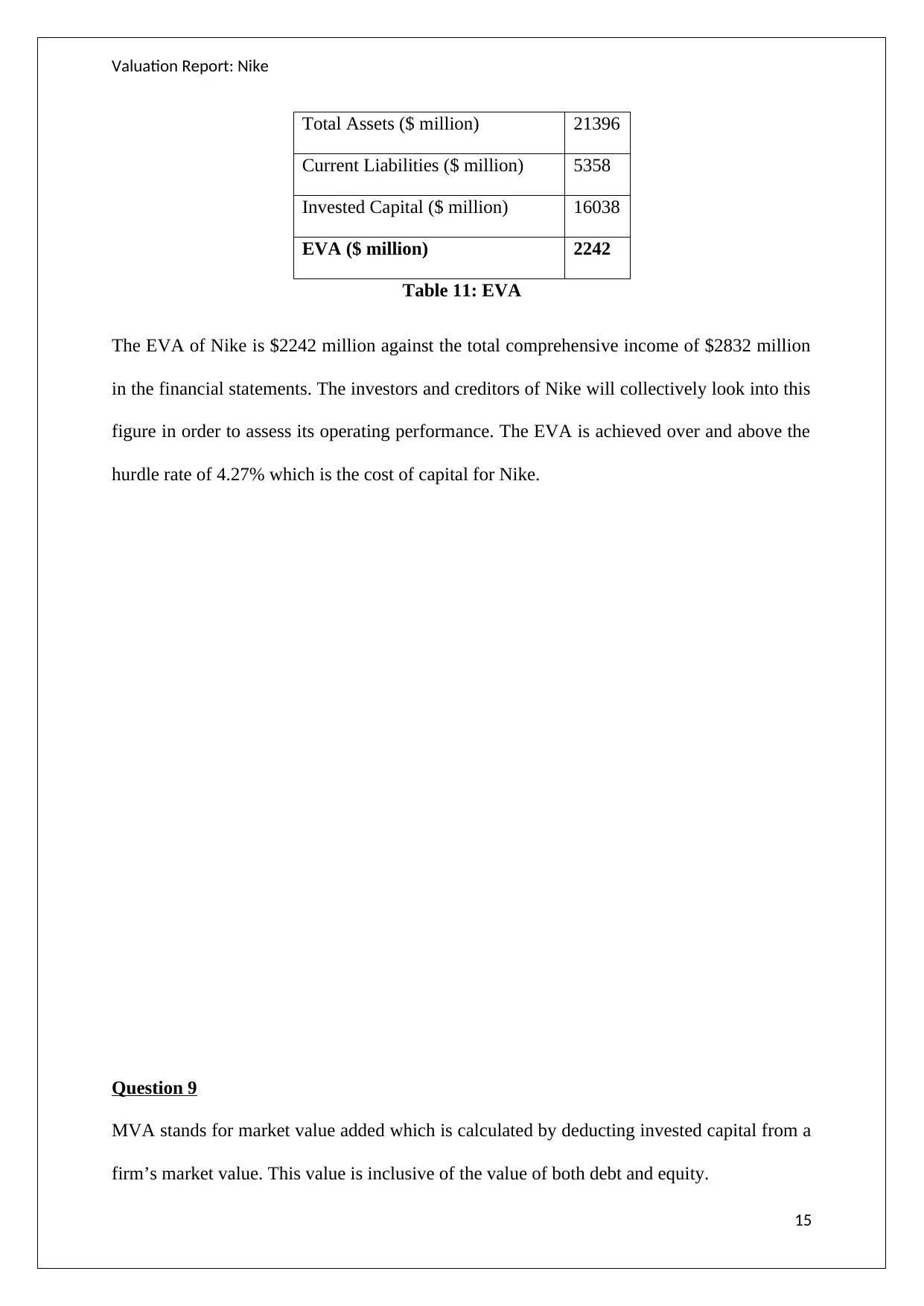
Valuation Report: Nike
Total Assets ($ million) 21396
Current Liabilities ($ million) 5358
Invested Capital ($ million) 16038
EVA ($ million) 2242
Table 11: EVA
The EVA of Nike is $2242 million against the total comprehensive income of $2832 million
in the financial statements. The investors and creditors of Nike will collectively look into this
figure in order to assess its operating performance. The EVA is achieved over and above the
hurdle rate of 4.27% which is the cost of capital for Nike.
Question 9
MVA stands for market value added which is calculated by deducting invested capital from a
firm’s market value. This value is inclusive of the value of both debt and equity.
15
Total Assets ($ million) 21396
Current Liabilities ($ million) 5358
Invested Capital ($ million) 16038
EVA ($ million) 2242
Table 11: EVA
The EVA of Nike is $2242 million against the total comprehensive income of $2832 million
in the financial statements. The investors and creditors of Nike will collectively look into this
figure in order to assess its operating performance. The EVA is achieved over and above the
hurdle rate of 4.27% which is the cost of capital for Nike.
Question 9
MVA stands for market value added which is calculated by deducting invested capital from a
firm’s market value. This value is inclusive of the value of both debt and equity.
15
Paraphrase This Document
Need a fresh take? Get an instant paraphrase of this document with our AI Paraphraser
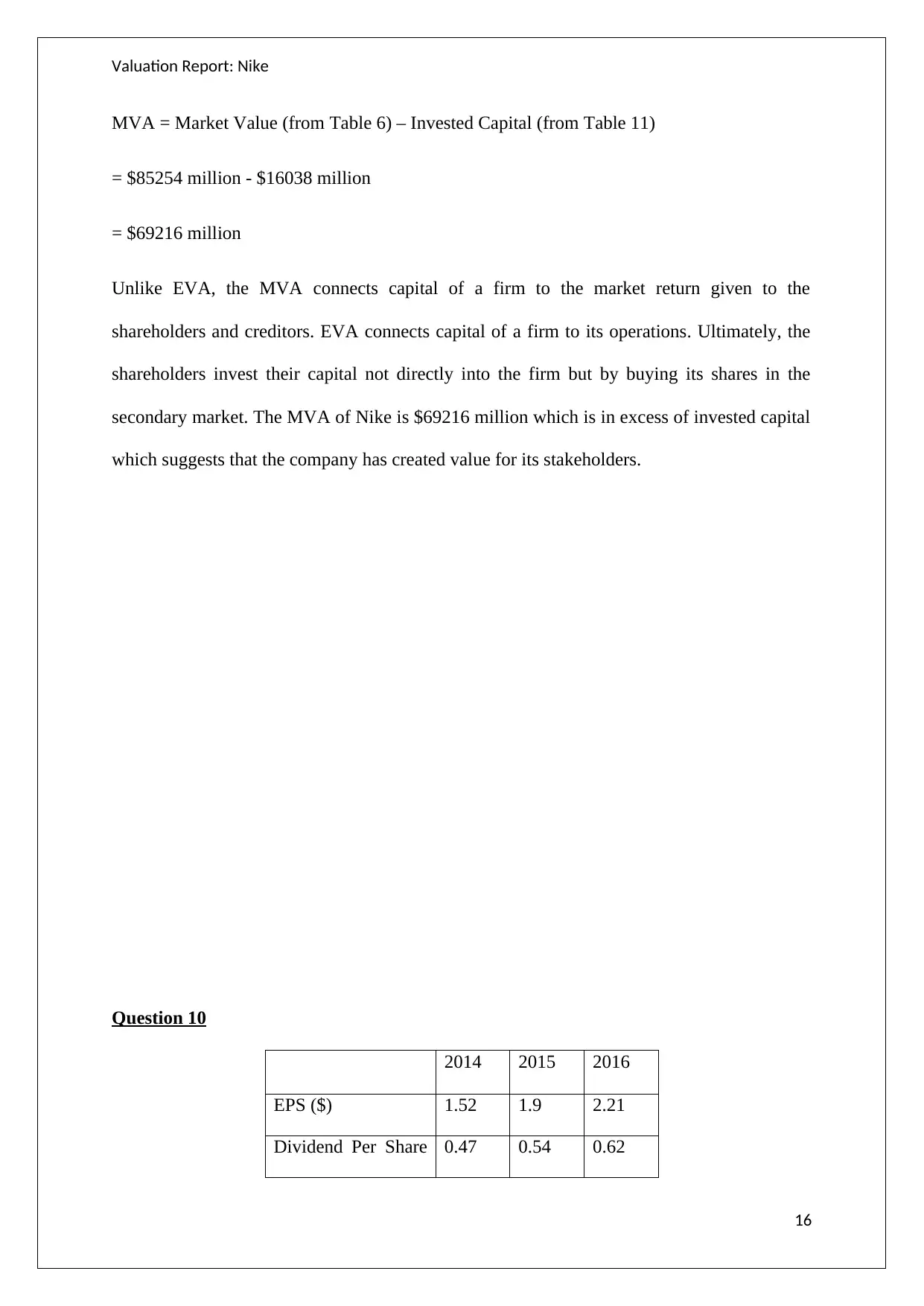
Valuation Report: Nike
MVA = Market Value (from Table 6) – Invested Capital (from Table 11)
= $85254 million - $16038 million
= $69216 million
Unlike EVA, the MVA connects capital of a firm to the market return given to the
shareholders and creditors. EVA connects capital of a firm to its operations. Ultimately, the
shareholders invest their capital not directly into the firm but by buying its shares in the
secondary market. The MVA of Nike is $69216 million which is in excess of invested capital
which suggests that the company has created value for its stakeholders.
Question 10
2014 2015 2016
EPS ($) 1.52 1.9 2.21
Dividend Per Share 0.47 0.54 0.62
16
MVA = Market Value (from Table 6) – Invested Capital (from Table 11)
= $85254 million - $16038 million
= $69216 million
Unlike EVA, the MVA connects capital of a firm to the market return given to the
shareholders and creditors. EVA connects capital of a firm to its operations. Ultimately, the
shareholders invest their capital not directly into the firm but by buying its shares in the
secondary market. The MVA of Nike is $69216 million which is in excess of invested capital
which suggests that the company has created value for its stakeholders.
Question 10
2014 2015 2016
EPS ($) 1.52 1.9 2.21
Dividend Per Share 0.47 0.54 0.62
16

Valuation Report: Nike
($)
Dividend Payout
Ratio
30.92
%
28.42% 28.05%
Table 12: Dividend Payout Ratio
As shown in the table, the dividend payout ratio of Nike is consistent with the EPS growth.
The company has paid dividend in the range of 28-31 % of earning per share of common
equity. Besides, the dividend increases with the increase in earnings. Thus, the dividend
policy of Nike is in line with the growth of the earnings.
Question 11
According to Gordon’s Dividend Growth Model, the intrinsic value per share of common
equity can be calculated using the following equation:
V = D1 / (k - g)
Where, D1 = Estimated Dividend Payout Next Year
17
($)
Dividend Payout
Ratio
30.92
%
28.42% 28.05%
Table 12: Dividend Payout Ratio
As shown in the table, the dividend payout ratio of Nike is consistent with the EPS growth.
The company has paid dividend in the range of 28-31 % of earning per share of common
equity. Besides, the dividend increases with the increase in earnings. Thus, the dividend
policy of Nike is in line with the growth of the earnings.
Question 11
According to Gordon’s Dividend Growth Model, the intrinsic value per share of common
equity can be calculated using the following equation:
V = D1 / (k - g)
Where, D1 = Estimated Dividend Payout Next Year
17

Valuation Report: Nike
k = required rate of return for common equity shareholders/cost of equity
g = perpetuity growth rate of dividends
The return on equity value was used to forecast free cash flows previously. The same rate of
28.17 % is used to project next year’s dividend. The perpetuity growth rate of dividend is
assumed to be as 1%.
Particulars Value
Current Year
Dividend
0.62
Growth Rate 28.17%
D1 0.79
k 4.32%
g 1.00%
Intrinsic Value per
Share
23.96
Table 13: Intrinsic Value (Gordon’s Dividend Growth model)
Question 12
The intrinsic value per share obtained in question 7 using DCF model is $124.84 while in
table 13 using Gordon’s model it is $23.96. The value obtained using DCF is five times more
than that obtained using Gordon’s model. It is because the latter model does not include the
retained earnings which are ploughed back into the business to further increase the
shareholder value.
18
k = required rate of return for common equity shareholders/cost of equity
g = perpetuity growth rate of dividends
The return on equity value was used to forecast free cash flows previously. The same rate of
28.17 % is used to project next year’s dividend. The perpetuity growth rate of dividend is
assumed to be as 1%.
Particulars Value
Current Year
Dividend
0.62
Growth Rate 28.17%
D1 0.79
k 4.32%
g 1.00%
Intrinsic Value per
Share
23.96
Table 13: Intrinsic Value (Gordon’s Dividend Growth model)
Question 12
The intrinsic value per share obtained in question 7 using DCF model is $124.84 while in
table 13 using Gordon’s model it is $23.96. The value obtained using DCF is five times more
than that obtained using Gordon’s model. It is because the latter model does not include the
retained earnings which are ploughed back into the business to further increase the
shareholder value.
18
Secure Best Marks with AI Grader
Need help grading? Try our AI Grader for instant feedback on your assignments.

Valuation Report: Nike
Question 13
Nike’s capital structure policy can be analysed by taking book value rates for both debt and
equity. The following table shows Nike’s capital structure based on book value rates.
Particulars Book
Value ($
million)
Proportio
n
Equity 12258 85.65%
Debt 2054 14.35%
19
Question 13
Nike’s capital structure policy can be analysed by taking book value rates for both debt and
equity. The following table shows Nike’s capital structure based on book value rates.
Particulars Book
Value ($
million)
Proportio
n
Equity 12258 85.65%
Debt 2054 14.35%
19

Valuation Report: Nike
Total 14312 100%
Table 14: Capital Structure
The proportion of debt has been kept low and more than 95% of it is through corporate
bonds. The credit rating agency Standard and Poor’s has assigned AA- rating to Nike’s debt
offering with stable outlook. The company has low debt compared to its stability in paying
interest expense
Question 14
The value of Beta derived for Nike from Yahoo Finance is levered. The unlevered value of
beta subtracts the effect of debt from the beta to arrive at risk posed by only equity part. The
formula to arrive at unlevered beta is as follows:
Bu = BL / (1+ (1- Tc) × (D/E))
Where, Tc = Tax Rate
D/E = Debt-Equity Ratio
Particulars Value
20
Total 14312 100%
Table 14: Capital Structure
The proportion of debt has been kept low and more than 95% of it is through corporate
bonds. The credit rating agency Standard and Poor’s has assigned AA- rating to Nike’s debt
offering with stable outlook. The company has low debt compared to its stability in paying
interest expense
Question 14
The value of Beta derived for Nike from Yahoo Finance is levered. The unlevered value of
beta subtracts the effect of debt from the beta to arrive at risk posed by only equity part. The
formula to arrive at unlevered beta is as follows:
Bu = BL / (1+ (1- Tc) × (D/E))
Where, Tc = Tax Rate
D/E = Debt-Equity Ratio
Particulars Value
20
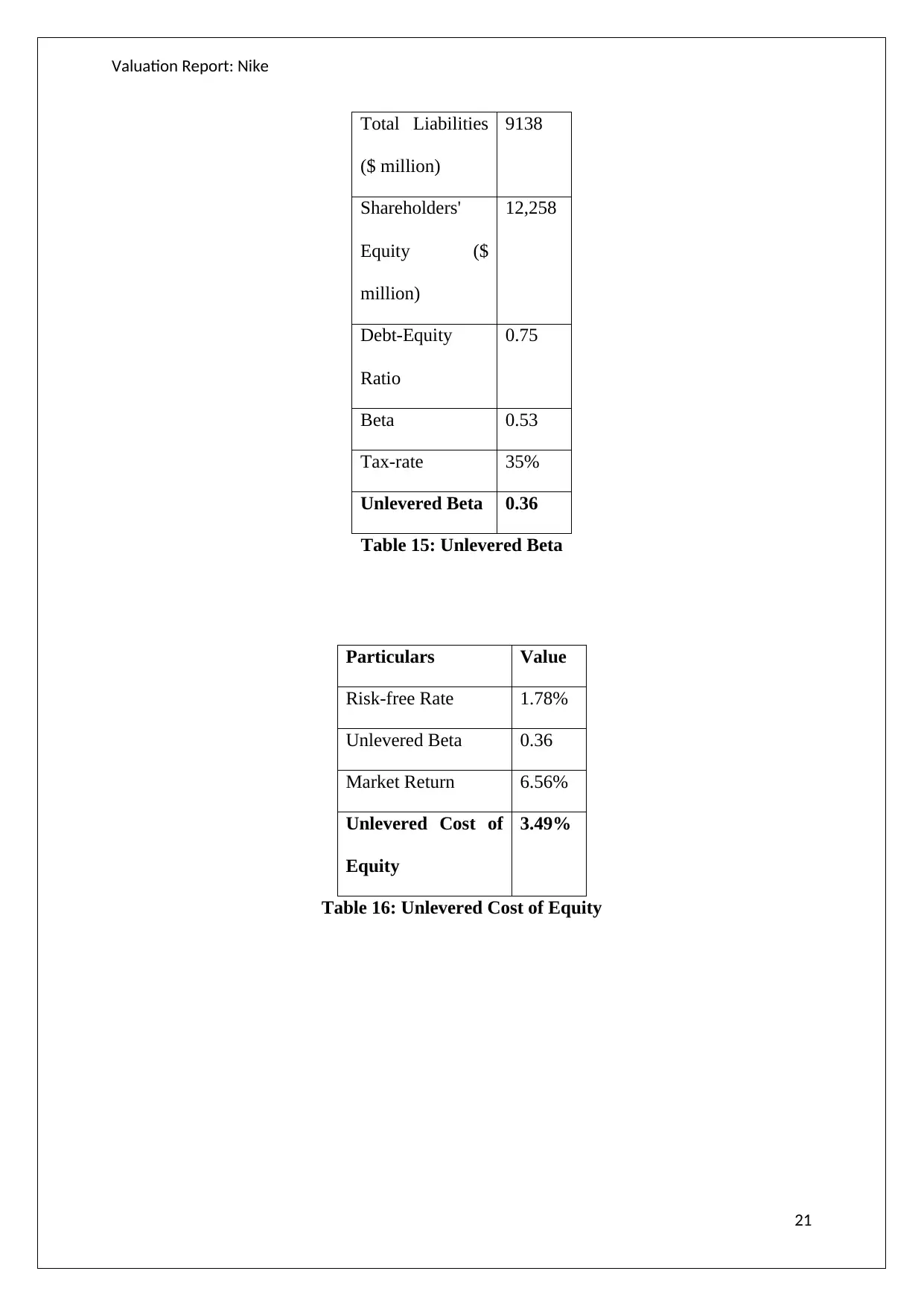
Valuation Report: Nike
Total Liabilities
($ million)
9138
Shareholders'
Equity ($
million)
12,258
Debt-Equity
Ratio
0.75
Beta 0.53
Tax-rate 35%
Unlevered Beta 0.36
Table 15: Unlevered Beta
Particulars Value
Risk-free Rate 1.78%
Unlevered Beta 0.36
Market Return 6.56%
Unlevered Cost of
Equity
3.49%
Table 16: Unlevered Cost of Equity
21
Total Liabilities
($ million)
9138
Shareholders'
Equity ($
million)
12,258
Debt-Equity
Ratio
0.75
Beta 0.53
Tax-rate 35%
Unlevered Beta 0.36
Table 15: Unlevered Beta
Particulars Value
Risk-free Rate 1.78%
Unlevered Beta 0.36
Market Return 6.56%
Unlevered Cost of
Equity
3.49%
Table 16: Unlevered Cost of Equity
21
1 out of 22
Related Documents
Your All-in-One AI-Powered Toolkit for Academic Success.
+13062052269
info@desklib.com
Available 24*7 on WhatsApp / Email
![[object Object]](/_next/static/media/star-bottom.7253800d.svg)
Unlock your academic potential
© 2024 | Zucol Services PVT LTD | All rights reserved.





